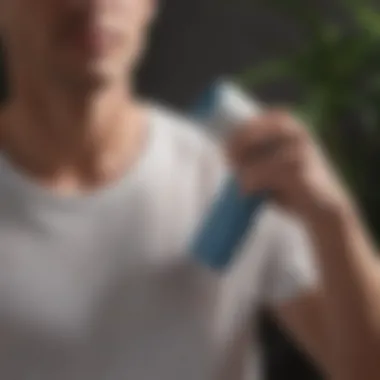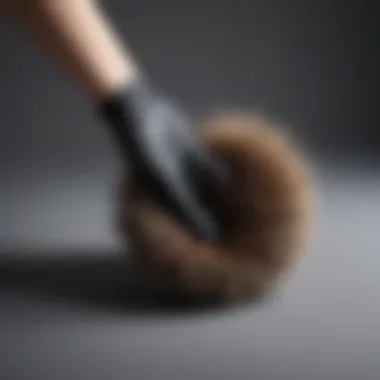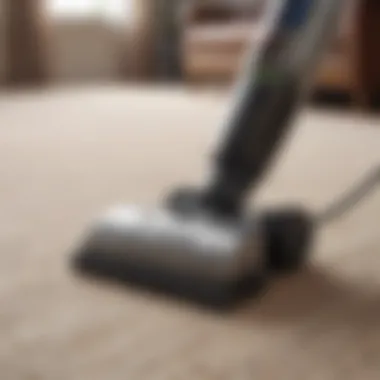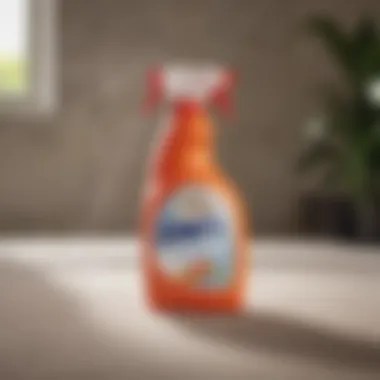Effective Ways to Get Pet Hair Off Clothes


Intro
Pet ownership can be a rewarding experience, but it often comes with its own set of challenges, notably the ubiquitous presence of pet hair. This unwelcome addition can cling to clothes, showing up at the worst moments—in meetings, social gatherings, or simply on a leisurely day out. Getting rid of pet hair isn't just about aesthetics; it's about maintaining a polished look while still cherishing our furry friends. Here, we explore various techniques designed to help homeowners and pet lovers manage this common nuisance seamlessly.
Design Inspirations
When considering how to keep clothes free from pet hair, design inspirations may initially seem out of place. However, selecting the right colors, fabrics, and styles can greatly affect how visible pet hair might be on clothing.
Trending Styles
It’s often said that you should dress to impress, but dressing to outsmart pet hair carries equal weight. Opting for textured fabrics like corduroy or wool can help disguise the presence of pet hair better than smoother surfaces. Darker colors also prove more effective at hiding stray fur; for instance, a deep navy or charcoal can be less revealing than a light shade.
For those wanting to stay ahead of the curve, choosing high-performance clothing, often marketed as ‘anti-static’ or ‘fur-repelling’, is another route to consider.
Color Palettes
While the latest trends come and go, some colors seem to endure the test of time and pet hair. It often is wise to select garments in shades that contrast with your pet’s fur. For example, if you have a golden retriever, avoid light yellows and whites; instead, lean towards greens or earthy tones. Meanwhile, if you’re a cat owner with black furballs roaming your home, wearing lighter tones can help diminish the appearance of the hair.
Maintenance and Upkeep
Maintaining a pet-friendly wardrobe requires a proactive approach, encompassing routine cleaning habits and clever strategies.
Seasonal Maintenance Checklist
As seasons change, so do the types of fabrics and clothes one wears. Keeping a seasonal checklist can aid in minimizing pet hair accumulation. Here’s a practical list:
- Spring/Summer: Consider lightweight fabrics that can be easily washed and dried. Choose garments with more textured surfaces, as they tend to attract less hair.
- Fall/Winter: Invest in garments that are easier to de-fur. Outerwear can be the biggest nuisance; using a lint roller or sticky tape after every wear can have a huge impact.
- All Year: Regularly wash pet bedding and designated sitting areas; this helps keep loose fur from spread onto clothing over time.
Cleaning and Organization Tips
Regularly scheduled cleaning can make all the difference. Make sure to:
- Use a lint roller: Keep this handy in your car or purse. It’s quick and effective at catching rogue hairs.
- Damp cloth or rubber glove: Rubbing a slightly damp cloth or glove over surfaces can bundle hair up for easy removal.
- Invest in a pet hair vacuum: A specialized vacuum is worth its weight in gold. It’s designed to tackle fur on upholstery and clothing alike effectively.
- Separate care baskets: Create designated baskets or spaces for pet areas, so you can quickly tend to clothing that has hair on it, preventing it from mingling with your closet.
"Prevention is better than a cure." Incorporating these routines can lessen the stress of dealing with pet hair on clothing.
By tailoring wardrobe choices and implementing simple maintenance routines, anyone can step out confidently, whether heading to the office or out for a night on the town, all while enjoying the company of their beloved pets.
Understanding the Challenge of Pet Hair
Pet hair is more than simply an aesthetic nuisance; it poses a genuine challenge for many pet owners. Fur has a knack for weaving itself into clothing fibers, clinging on like a child to their favorite toy. This article delves into the reasons behind the persistent presence of pet hair and suggests various strategies for dealing with it. By understanding the characteristics of pet fur, you can better approach the situation.
The Nature of Pet Fur
Pet fur comes in a myriad of types and textures, from the fine hairs of a Siamese to the thick coat of a golden retriever. Each breed has its own shedding cycle, and some may drop a conspicuous amount of hair, especially during seasonal changes. The texture and length of pet hair play a role in how it interacts with fabrics. Short, coarse hairs are notorious for getting caught in tight weaves, while longer strands may simply glisten on the surface, easy to spot yet frustrating to remove.
Furthermore, pet fur can attract and hold onto dust and other particulates, creating a more significant mess. The composition of the hair can also vary; some pets have hair that's quite oily, enhancing its ability to stick and cling. Understanding these components allows pet owners to tailor their cleaning methods specifically to their pet’s unique fur conditions, making their wardrobe a little easier to manage.
Why Hair Sticks to Clothes
The stickiness of pet hair and its uncanny ability to cling to clothing can be attributed to static electricity and the texture of both the fur and the fabric. Clothing made from synthetic fibers, like polyester and nylon, tends to generate static, which attracts hair, much like how balloons can stick to walls. In contrast, natural fibers like cotton or wool tend to be less prone to holding onto hair.


"The right fabric can make all the difference in resisting pet hair accumulation."
Consider any clingy garments in your closet; these often play host to pet hair more than others. Adding a bit of fabric softener can help reduce static cling, making it easier to dislodge the fur. Additionally, techniques such as regular cleaning of your washing machine filter and consistent lint rolling can keep the accumulation at bay. Addressing these factors might not eliminate the fur entirely but can certainly alleviate the headache of finding it in unexpected places.
Initial Strategies for Hair Removal
Removing pet hair from clothes can feel like an uphill battle, especially for those who adore their furry companions. This section presents initial actions that can ease the effort of keeping clothing fur-free. Implementing effective strategies before the laundry process begins can be immensely beneficial. It can also save time, keeping your favorite outfits cleaner, longer.
Before Washing: Quick Fixes
Before diving into the washing machine, there are simple yet powerful quick fixes to tackle pet hair. One of them involves using a lint roller. Many people swear by these handheld rollers. They're easy to use—just roll them over your clothes, and you'll notice a significant reduction in fur almost instantly. Just be gentle to avoid tearing any delicate fabric.
An alternative approach is to use duct tape or masking tape. Wrap a piece around your hand, sticky side out, and pat down areas where fur has accumulated. As strange as it might sound, this method can help lift away stubborn strands effectively.
Another trick is to use a damp sponge. Simply wipe the garment with a slightly dampened sponge, and watch the hair cling to it. Alternatively, you can moisten a cloth, let it dry a bit, and then swipe it over the fabric. It’s like magic!
"The right quick fix is sometimes all you need before the big wash – consider it the appetizer before the main course. "
Washing Techniques to Consider
When it comes to the washing stage, the right techniques can make all the difference in the world. Start by making sure to shake out your clothes before tossing them into the wash. This simple act can dislodge loose fur, giving your washer a head start.
Using a laundry bag can be another useful technique, particularly for lighter fabrics. Organize clothes into mesh bags, as this helps to restrict fabric movement and allows for better hair encapsulation. It might seem small, but a simple laundry bag ensures that the pet hair doesn't transfer to other garments.
Also, don’t underestimate the power of fabric softeners. Adding them during the rinse cycle can help reduce static cling, which is often the culprit for hair sticking to clothes. An additional option is to switch to dryer sheets. These not only add softness but also work to separate haired clothing from one another during drying.
In short, arming yourself with quick fixes and proper washing techniques can reduce the hassle of pet hair on clothes, making the life of pet owners a bit easier.
Tool-Based Approaches for Effective Removal
When it comes to battling pet hair, effective tools can make all the difference. Not only can they save time and energy, but they can also offer a level of cleanliness that simple methods might not achieve. This section dives into several tool-based strategies designed to tackle that relentless coat of fur that seems to cling to everything.
Using the right tools helps target pet hair specifically, allowing for efficient removal without damaging your clothing. The benefits of tool-based approaches are many; they can reach those pesky areas where hands or less precise methods might fall short. Whether you’re getting ready for work or preparing for a gathering, a quick reach for one of these tools can ensure you leave the house looking sharp and fur-free.
Lint Rollers: A Staple for Pet Owners
Lint rollers are practically the best friends of pet owners. With an easy-to-use design, they consist of a handle and a roll of sticky paper. A few quick swipes across your clothes can lift off hair with ease. What makes them particularly attractive is their portability. You can toss one in your bag, making it handy for on-the-go touch-ups.
When choosing a lint roller, consider the size of the sheets. Larger sheets can cover more area in a single swipe, saving time, while smaller ones can reach into tighter spots. Environmental consciousness has also led to the creation of reusable lint rollers, made of silicone or other materials that can be rinsed clean.
Pet Hair Removal Brushes: Options Available
Brushes specifically designed for pet hair removal come in different styles and materials. Unlike standard brushes, these tools have bristles that excel in catching hair while brushing through fabric. Rubberized brushes are particularly effective, as the sticky nature of rubber attracts hair like a magnet.
Here are a few options:
- Double-sided brushes offer both a coarse side for heavy-duty cleaning and a softer side for delicate fabrics.
- Foldable brushes are compact and fit easily into purses or bags, perfect for travel.
- Motorized brushes, though more expensive, promise greater suction power and efficiency.
Using these brushes not only helps remove hair but can also help maintain your garments by preventing and other fabric issues.
Vacuum Cleaners: Advanced Features to Seek
When lint rollers and brushes aren’t enough, a good vacuum cleaner can come to the rescue. Many modern vacuum cleaners come equipped with features specifically made for dealing with pet hair. Here’s what to look for:


- Pet attachments: These specialized nozzles and brushes are designed to loosen and lift pet hair from fibers more effectively than standard attachments.
- Strong suction power: A vacuum that boasts high suction can pull hair up from deeper within the fabric.
- Filter systems: HEPA filters are crucial as they trap allergens and dander, which can be a blessing for allergy sufferers.
- Cordless options: If mobility's key for you, a cordless vacuum lets you clean up those rogue hairs all over the house without fussing with a plugged-in cord.
"Whether it’s a quick visit from a friend or a festive gathering, having the right tools on hand ensures that pet fur won’t steal the spotlight or undermine your efforts to look polished."
In summary, incorporating tool-based approaches enhances not just the ease of pet hair removal but also the aesthetic quality of your wardrobe. With the range of tools available today – from lint rollers to specialized vacuum attachments – maintaining pet hair-free clothes can become a seamless part of your daily routine.
Household Items for Pet Hair Removal
When it comes to tackling the ever-persistent problem of pet hair on clothes, the use of household items can be a game changer. Everyday objects that you already have might just be the secret weapon you need. Utilizing these common tools not only saves money but also provides quick and accessible solutions that can fit seamlessly into your routine. Let’s break down some of these clever hacks that can help you keep your wardrobe fur-free without breaking a sweat.
Using Rubber Gloves Effectively
Rubber gloves are often looked upon as simplistic cleaning tools, but their effectiveness in removing pet hair cannot be overstated. The rubber material creates static electricity when you rub your hands against fabric, making it easier for hair to cling to the glove rather than your clothing. This method is straightforward: put on a pair of clean rubber gloves, and gently run your hands over the fabric with a scrubbing motion. You’d be surprised at how much fur sticks to them. When they get covered in hair, just rinse the gloves under warm water, and repeat. Not only does this technique work wonders on clothes, but it can also be applied to upholstery and blankets.
Creating a Sticky Tape Solution
If you’re in a bind and don’t have time for a thorough clean, sticky tape can come to the rescue. This is one of those quick fixes that truly does the trick. Simply take a roll of packing tape, duct tape, or even masking tape, and tear off a strip. Press the sticky side against your fabric and pull it away quickly. As the tape comes off, it lifts pet hair right along with it. For larger surfaces, wrapping the tape around your hand, sticky side out, allows for even coverage and reach into those tricky spots. The best part? This method is quick, discreet, and highly effective.
The Role of Fabric Softener
Fabric softener isn’t just about making your clothes smell nice; it plays a pivotal role in dealing with pet hair. When you use a dryer sheet or liquid softener in the wash, it creates a barrier on the fabric that helps loosen pet hair from clothing. In the wash cycle, the softener minimizes static cling, which in turn reduces the chance of hair sticking to your prime garments. During the drying process, tossing in a dryer sheet along with your clothes helps grab even more loose hairs, pulling them into the lint trap as your clothes tumble.
"Using household items for pet hair removal not only enhances cleanliness but also fosters resourcefulness in managing everyday challenges."
To wrap it up, these household items bring practicality and efficiency to the table. They’re easy to use and can make a notable difference in how you maintain your clothing and overall aesthetics, especially for those who share their lives with furry companions.
Preventing Pet Hair Accumulation
When it comes to living with our furry friends, the last thing we want is a wardrobe full of pet hair. Preventing pet hair from accumulating on your clothes isn’t just about cleaning up after your pet; it’s about fostering a lifestyle that harmonizes pet ownership with maintaining a neat appearance. Simple adjustments can make a world of difference.
Choosing Pet-Friendly Fabrics
Selecting the right clothing can significantly reduce hair cling. Fabrics like microfiber, denim, and certain synthetic materials tend to repel pet hair better than cotton or wool. Microfiber, for example, has tightly woven fibers that don’t allow pet hair to latch on easily. Keep an eye out for fabric blends that mix synthetic fibers with natural ones, as they are often more resistant to hair accumulation.
- Opt for:
- Avoid:
- Microfiber
- Denim
- Synthetic blends
- Cotton
- Wool
- Flannels
By being mindful of your wardrobe choices, you can lessen the time spent trying to remove those pesky hairs and enjoy being with your pet without the added worry of constant cleanup.
Establishing a Clothing Routine
Incorporating a routine that includes wearing specific clothes when interacting with your pets can be a game-changer. For instance, designating certain outfits as "pet days" can help keep hair off your favorite garments. One idea is to keep a pet-friendly stash of loungewear or comfortable clothes at hand.
- Designate days for:
- Laundry days with a focus on pet-friendly clothes.
- Special occasions where no furry friends are allowed near your outfit.
This helps in compartmentalizing your clothing and can shift your focus on cleaning as a whole, rather than being reactive to pet hair covering everything you own. These minor changes can save you from frustration in the long run.


Designating Pet-Free Zones
Creating boundaries in your home is another effective way to keep pet hair at bay. Designate specific areas in your home as "pet-free zones" where pets are not allowed. These could be bedrooms, certain parts of the living room, or even specific pieces of furniture. This step is crucial because it limits the contact your clothes have with pet hair.
Consider the following:
- Establish clear boundaries:
- Use baby gates to physically block access.
- Choose rooms where pets are not allowed.
By having these zones, you reduce not only the amount of pet hair on your clothing but also create safe havens for yourself that can feel like a calm retreat from the fur chaos.
"A little prevention goes a long way; taking small steps can lead to big changes in keeping pet hair off your clothes."
Overall, preventing pet hair accumulation is about being proactive rather than reactive. By choosing the right fabrics, establishing a clothing routine, and creating designated spaces for you and your pets, you can enjoy the companionship of your animals without the nagging worry of constant hair cleanup on your wardrobe.
Special Considerations for Different Fabrics
Understanding how pet hair interacts with various fabrics is essential for effective removal. Different materials react differently to pet fur, influencing both the methods you use and the potential success of your efforts. By tailoring your approach to the specific fabric, you not only increase the chances of success but also preserve the integrity of your clothing. For instance, delicate fabrics may need gentler techniques to avoid damage, while sturdy materials can withstand more vigorous removal methods. This awareness can save time, money, and frustration, ensuring your wardrobe remains in top shape while cohabitating with fluffy companions.
Dealing with Delicate Fabrics
When it comes to fabrics like silk, chiffon, or lace, the key words are gentle and strategic. These materials often trap hair in their fibers, making it seem like a steadfast enemy during the laundry process. Here are some tips for managing pet hair on delicate fabrics without causing harm:
- Use a Lint Roller: This tool is a godsend. Lightly roll it over the surface to lift hair away. Avoid pressing too hard to prevent damage.
- Static Electricity Tricks: A simple trick involves dampening your hands slightly and rubbing the fabric with them. The static can help lift hair without aggressive scrubbing.
- Hand Washing: If the fabric allows, hand washing can reduce agitation and help prevent hair from embedding deeper into the fibers.
- Air-Dry: When you can, let delicate clothes air-dry. This minimizes the chances of excessive heat damaging the fabric and trapping hair.
In delicate fabrics, your aim is to be light-handed while being effective. Being forewarned about the risks associated with certain cleaning methods allows for a safer approach.
Strategies for Heavy Materials
For fabrics like denim, canvas, or wool, the approach shifts. These materials tend to hold up to robust cleaning methods, making your options wider. Here’s how to tackle heavy fabrics effectively:
- Rubber Brushes or Gloves: Just like before, rubber has a strong affinity for hair removal. A rubber brush can work through the thick fibers of heavier fabrics, gathering hair without causing distress to the material.
- Washing Machine with Enhanced Options: Utilize a wash cycle specifically intended for heavy-duty fabrics. Some machines also have a hair-removal setting that can help loosen pet fur during washing.
- Dryer Sheets: Tossing a dryer sheet into the dryer can help reduce static cling, making it easier for loose hair to be collected by the dryer’s lint trap.
- Vacuum with Attachments: Many vacuums come with specialty pet hair attachments that are perfect for grabbing fur from heavy fabrics, particularly upholstery or outwear.
These strategies ensure that heavier materials are treated appropriately and that their lifespan isn't compromised due to improper cleaning.
"In managing pet hair, the fabric type dictates the approach—knowing whether to brush gently or scrub hard can save your clothes."
Final Thoughts on Managing Pet Hair
Managing pet hair on clothing can often seem like an uphill battle, but understanding and implementing effective techniques can alleviate a lot of frustration. This section delves into the importance of reflecting on your current methods and being adaptable in your approach. The goal here isn’t just to remove pet hair but to enjoy a better quality of life with your furry friends, without the constant worry of an unwanted furry coat on your attire.
Assessing Your Current Methods
To truly understand how well you’re managing pet hair, take a moment to evaluate the techniques you’re currently using. Many homeowners might think they have a solid routine figured out, but often, it can be beneficial to revisit those habits. Ask yourself questions like:
- Are my current tools effectively targeting pet hair?
- Am I utilizing often-overlooked household items that could assist in hair removal?
- Do I have a consistent routine to manage pet hair accumulation?
The answers will steer you towards either reinforcing your existing methods or seeking alternatives that may prove to be more efficient. For instance, if you're strictly using a lint roller, consider how effective that is on heavy fabrics versus lighter ones. You might find that incorporating rubber gloves or a specialized pet brush could yield better results.
Adjusting Techniques as Needed
Life with pets is unpredictable; so should be your method for dealing with their fur. What works one season might not work the next. If your methods feel stale, don’t hesitate to shake things up. Here are a few considerations:
- Seasonal Changes: Keep in mind that shedding varies with the seasons. During spring, you might need to amp up your hair-removal strategies to tackle increased shedding.
- Fabric Differences: Each fabric behaves differently. Smooth fabrics tend to release hair more easily than textured surfaces. Adjust your cleaning approach depending on the materials involved.
- Dog vs. Cat Hair: Different pets have different types of fur. A cat’s fine fur can be trickier to remove than a dog's coarser hair, so tailor your approach to your pet's specific fur characteristics.
Consider this a living document of your hair management strategy—be ready to adapt and experiment! Understanding that there’s not always a one-size-fits-all solution can lead to more successful and enjoyable pet ownership.
"The measure of an owner isn’t how fur-free their clothes are, but how much joy they take in every moment with their pets."







